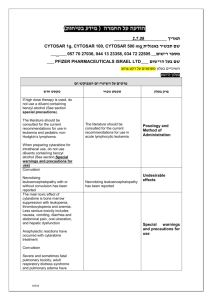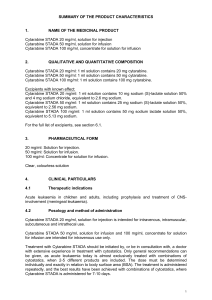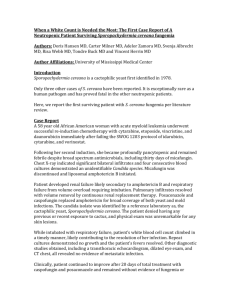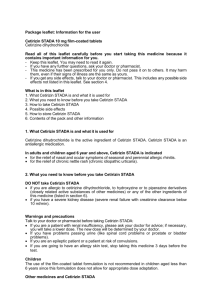Cytarabine STADA 20 mg per ml solution for injection ENG PL
advertisement
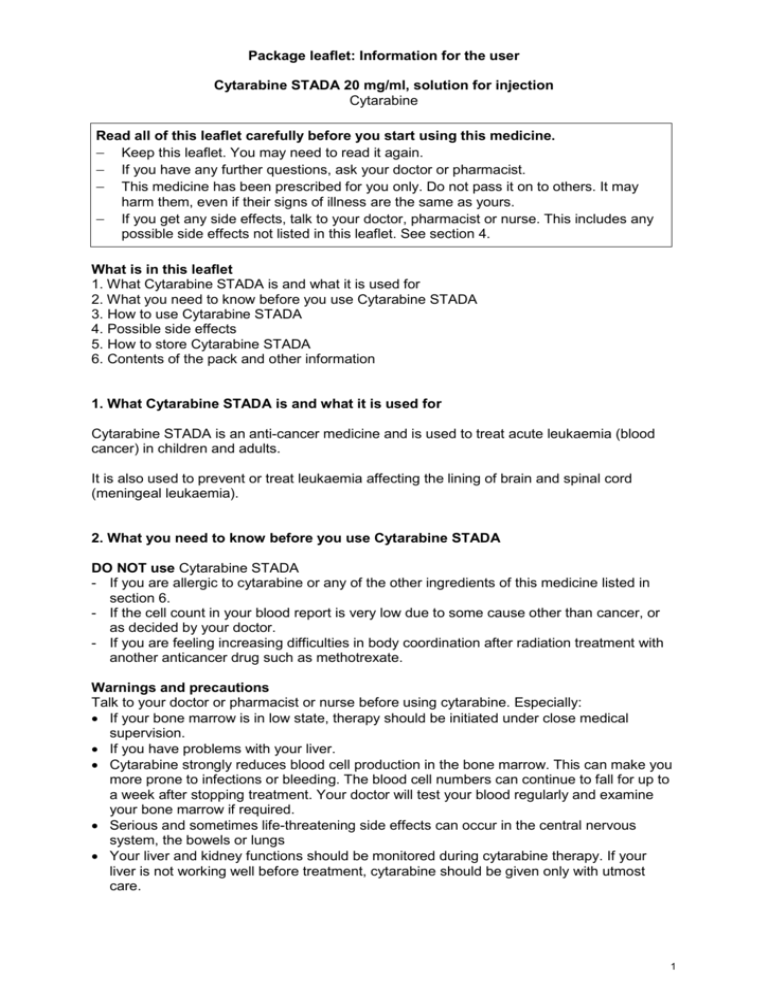
Package leaflet: Information for the user Cytarabine STADA 20 mg/ml, solution for injection Cytarabine Read all of this leaflet carefully before you start using this medicine. Keep this leaflet. You may need to read it again. If you have any further questions, ask your doctor or pharmacist. This medicine has been prescribed for you only. Do not pass it on to others. It may harm them, even if their signs of illness are the same as yours. If you get any side effects, talk to your doctor, pharmacist or nurse. This includes any possible side effects not listed in this leaflet. See section 4. What is in this leaflet 1. What Cytarabine STADA is and what it is used for 2. What you need to know before you use Cytarabine STADA 3. How to use Cytarabine STADA 4. Possible side effects 5. How to store Cytarabine STADA 6. Contents of the pack and other information 1. What Cytarabine STADA is and what it is used for Cytarabine STADA is an anti-cancer medicine and is used to treat acute leukaemia (blood cancer) in children and adults. It is also used to prevent or treat leukaemia affecting the lining of brain and spinal cord (meningeal leukaemia). 2. What you need to know before you use Cytarabine STADA DO NOT use Cytarabine STADA - If you are allergic to cytarabine or any of the other ingredients of this medicine listed in section 6. - If the cell count in your blood report is very low due to some cause other than cancer, or as decided by your doctor. - If you are feeling increasing difficulties in body coordination after radiation treatment with another anticancer drug such as methotrexate. Warnings and precautions Talk to your doctor or pharmacist or nurse before using cytarabine. Especially: If your bone marrow is in low state, therapy should be initiated under close medical supervision. If you have problems with your liver. Cytarabine strongly reduces blood cell production in the bone marrow. This can make you more prone to infections or bleeding. The blood cell numbers can continue to fall for up to a week after stopping treatment. Your doctor will test your blood regularly and examine your bone marrow if required. Serious and sometimes life-threatening side effects can occur in the central nervous system, the bowels or lungs Your liver and kidney functions should be monitored during cytarabine therapy. If your liver is not working well before treatment, cytarabine should be given only with utmost care. 1 The levels of uric acid (showing that the cancer cells are destroyed) in your blood (hyperuricaemia) may be high during treatment. Your doctor will tell you if you need to take any medicine to control this. During treatment with cytarabine administration of live or attenuated vaccine is not advised. If required, consult your doctor. Use of killed or inactivated vaccine may not have the desired effect due to suppressed immune system while on cytarabine. Do not forget to tell you doctor if you have received radiotherapy. Other medicines and Cytarabine Tell your doctor or pharmacist if you are taking, have recently taken or might take any other medicines, especially medicines containing 5-Fluorocytosine (a medicine used to treat fungal infections). medicines containing digitoxin or beta-acetyldigoxin, which are used to treat certain heart conditions. gentamicin (an antibiotic used to treat bacterial infections). medicines containing cyclophosphamide, vincristine and prednisone which are used in cancer treatment programmes. Pregnancy, breast-feeding and fertility Pregnancy Avoid becoming pregnant while you or your partner is being treated with Cytarabine. If you are sexually active, you are advised to use effective birth control to prevent pregnancy during treatment, whether you are male or female. Cytarabine may cause birth defects, so it is important to tell your doctor if you think you are pregnant. Men and women have to use effective contraception during and up to 6 months after treatment. Breast-feeding You should stop breast-feeding before starting treatment with Cytarabine because this medicine may be harmful to infants being breast-fed. Fertility Cytarabine may lead to suppression of menstrual cycles in females and lead to amenorrhoea and may suppress sperm production in male patients. Male patients undergoing cytarabine treatment should use a reliable contraceptive method. Ask your doctor or pharmacist for advice before taking any medicine. Driving and using machines Cytarabine does not affect your ability to drive or use machinery. However, cancer treatment in general can affect the ability of some patients to drive or operate machines. If you are affected, you should not drive or use machinery. Cytarabine STADA 20 mg/ml contains sodium This medicinal product contains 0.114 mmol (or 2.6 mg) sodium per 1 ml. To be taken into consideration by patients on a controlled sodium diet. 3. How to use Cytarabine STADA Cytarabine STADA can only be given under supervision by a doctor with experience in cancer treatment. Your doctor will decide about the dose you will receive. You may receive Cytarabine STADA either as an injection into a vein (intravenous), into a muscle (intramuscular), under the skin (subcutaneous) or into the space surrounding the spinal cord (intrathecal). If you use more Cytarabine STADA than you should High doses can worsen side effects like sores in the mouth or may decrease the number of white blood cells and platelets (these help the blood to clot) in the blood. Should this happen, 2 you may need antibiotics or blood transfusions. Mouth ulcers can be treated to make them less uncomfortable as they heal. If you have any further question on the use of this medicine, ask your doctor or pharmacist. 4. Possible side effects Like all medicines, this medicine can cause side effects, although not everybody gets them. The side effects of cytarabine are dependent on the dose. The digestive tract is most commonly affected, but also the blood. Tell your doctor or nurse immediately, if you suffer from the following symptoms after taking this medicine: An allergic reaction such as sudden wheeziness, difficulty in breathing, swelling of eyelids, face or lips, rash or itching (especially affecting the whole body). Severe allergic reaction (anaphylaxis): skin rash including red itchy skin, swelling of the hands, feet, ankles, face, lips mouth or throat (which may cause difficulty in swallowing or breathing), difficulty in breathing or wheezing (bronchospasm) and you may feel you are going to faint (a spontaneous loss of consciousness caused by insufficient blood to the brain). It may be fatal (uncommon). Clinical signs as present in pulmonary oedema/ARDS may develop, particularly in highdose therapy: acute, distressing breathing difficulties and water in the lungs (pulmonary oedema) have been observed, particularly at high doses (common). You are feeling tired and listless (lethargic). You have flu like symptoms e.g. raised temperature or fever and chills. Severe pain in the chest Severe pain in the abdomen Loss of vision, loss of sense of touch, mental disturbance or loss of ability to move normally (this medicine may cause side effects to the brain and eyes which are usually reversible but may be very serious) You bruise more easily or bleed more than usual if you hurt yourself. These are the symptoms of low numbers of blood cells. These are serious side effects. You may need urgent medical attention. Other reported side effects include: Common (may affect up to 1 in 10 people): - fever - not enough white and red blood cells or blood platelets, which may make you more prone to infections or bleeding o a fall in white blood cells can be accompanied by chills and fever that immediately require a medical opinion; o a fall in the platelet count can be accompanied by bleeding that immediately require a medical opinion, - abnormal blood cells (megaloblastosis) - loss of appetite - swallowing difficulty - belly ache (abdominal pain) - nausea (feeling sick) - vomiting - diarrhoea - inflammation or ulceration of the mouth or anus - reversible effects on the skin such as reddening (erythema), blistering, rash, hives, blood vessel inflammation (vasculitis), hair loss - reversible effects on the liver such as increased enzyme levels 3 - reversible effects on the eyes such as sore eyes with bleeding (haemorrhagic conjunctivitis) with vision disturbance, sensitivity to light (photophobia), watery or burning eyes and inflammation of the cornea (keratitis) - reduced consciousness (at high doses) - speaking difficulties (at high doses) - abnormal eye movements (nystagmus, at high doses) - inflammation of the vein at the site of injection - abnormally high blood uric acid levels (hyperuricaemia) Uncommon (may affect up to 1 in 100 people): - sore throat - headache - serious allergic reactions (anaphylaxis), causing for instance difficulty in breathing or dizziness - blood-poisoning (sepsis) - inflammation and ulcers of the gullet - severe bowel inflammation (necrotising colitis) - bowel cysts - ulceration of the skin - itching - inflammation at the site of injection - brown/black spots on the skin (lentigo) - yellowish skin and eye balls (jaundice) - lung infection (pneumonia) - breathing difficulty - paralysis of the legs and lower body can occur when cytarabine is given into the space surrounding the spinal cord - muscle and joint pain - inflammation of the lining that surrounds the heart (pericarditis) - impaired kidney function - inability to pass urine (urinary retention) - chest pain - burning pain of palms and soles Very Rare (may affect up to 1 in 10,000 people): - inflammation of sweat glands - irregular heartbeat (arrhythmias) Not Known (frequency cannot be estimated from the available data): - Damage to nervous tissue (Neural Toxicity) and inflammation of one or more nerves (neuritis) - Inflammation of the pancreas (Pancreatitis) - Sore eyes (conjunctivitis) Other side effects: The Cytarabine Syndrome may occur 6-12 h after the start of treatment. The symptoms include: - fever - bone and muscle pain - occasional chest pain - rash - sore eyes (conjunctivitis) - nausea (feeling sick) Your doctor may prescribe corticosteroids (anti-inflammatory medicines) to prevent or treat these symptoms. If they are effective, treatment with cytarabine may be continued. The following symptoms may develop after intrathecal treatment (injection into the space around the spinal cord) with cytarabine: 4 - inflammation and breakdown of the white matter of the brain (necrotising leukencephalopathy) - blindness - spinal cord injury resulting in paralysis of two or all four limbs (para- and quadriplegia) - nausea (feeling sick) - vomiting - headache - fever - other symptoms if a membrane surrounding brain and spinal cord is inflamed Reactions observed with higher-dose therapy Central nervous system: The following symptoms, which are usually reversible, may develop in up to one third of patients after treatment with high cytarabine doses: - personality changes - changed alertness - difficulty in speaking - problems of coordination - tremor - abnormal eye movements (nystagmus) - headache - peripheral motor and sensory neuropathies (damage to nerves of the peripheral nervous system) - confusion - sleepiness - dizziness - coma - convulsions These side effects may occur more often: - in elderly patients (>55 years of age) - in patients with impaired liver and kidney functions - after previous cancer treatment to the brain and spinal cord for instance radiotherapy or injection of cytostatic agents into the space around the spinal cord (intrathecal treatment) - with alcohol abuse The risk of nervous system damages increases if the cytarabine treatment: - is given at high doses or at short intervals - is combined with other treatments that are toxic to the nervous system (such as radiotherapy or methotrexate) Digestive tract: Especially in treatment with high doses of cytarabine more severe reactions may appear in addition to the common symptoms. Perforation, death (necrosis) and obstruction of the bowel and inflammation of the inner belly lining have been reported. Liver abscesses, liver enlargement, blockage of liver veins and inflammation of the pancreas have been observed after high-dose therapy. The side effects on the digestive tract are less if cytarabine is given by infusion. Lungs: Acute, distressing breathing difficulties and water in the lungs (pulmonary oedema) have been observed, particularly at high doses. Others: - heart muscle disease (cardiomyopathy) - abnormal muscle breakdown (rhabdomyolysis) - blood infection (sepsis) 5 - corneal toxicity - viral, bacterial etc infections - loss of sperm and menstrual cycle Reporting of side effects If you get any side effects, talk to your doctor, pharmacist or nurse. This includes any possible side effects not listed in this leaflet. You can also report side effects directly via the national reporting system listed in Appendix V*. By reporting side effects you can help provide more information on the safety of this medicine. 5. How to store CYTARABINE STADA Your medicine is stored in a pharmacy and is prepared especially for you by experienced staff based on your doctor´s prescription. Keep out of the reach and sight of children. Do not use Cytarabine STADA after the expiry date which is stated on the vial and outer carton. Do not store above 25°C. 6. Contents of the pack and other information What Cytarabine STADA contains The active substance is cytarabine. 1 ml solution for injection contains 20 mg cytarabine. 1 vial of 2 ml contains 40 mg cytarabine. 1 vial of 5 ml contains 100 mg cytarabine. The other ingredients are sodium (S)-lactate solution, sodium chloride and water for injections. What Cytarabine STADA looks like and contents of the pack This medicine is a solution for injection. The solution is clear and colourless, and is filled in clear glass vials sealed with rubber stoppers and aluminium caps. The packages contain 10 vials of 2 ml and 5 ml, respectively. Not all pack sizes may be marketed. Marketing Authorisation Holder STADA Arzneimittel AG Stadastrasse 2-18 D-61118 Bad Vilbel Germany Manufacturer cell pharm GmbH Feodor-Lynen-Str. 35 D-30625 Hannover Germany 6 This medicinal product is authorised in the Member States of the EEA under the following names: Austria Cytarabin STADA 20 mg/ml Injektionslösung Finland CYTARABINE STADA 20 mg/ml injektioneste, liuos Portugal ARA-cell 20 mg/ml, solução injectável Sweden Cytarabine STADA 20 mg/ml injektionsvätska, lösning Netherlands Cytarabine CF 20 mg/ml, oplossing voor injectie This leaflet was last approved 2015-06-01 . --------------------------------------------------------------------------------------------------------------------------The following information is intended for medical or health care professionals only: Incompatibilities This medicinal product should not be mixed with other medicinal products except for those mentioned under “Handling”. Incompatibilities include heparin, insulin, methotrexate, 5-fluorouracil, nafcillin, oxacillin, penicillin G, and methyl-prednisolone succinate. Handling Cytarabine STADA should for infusion be diluted with sodium chloride solution, 9 mg/ml, or glucose solution, 50 mg/ml. Use of the infusion solution with closed transmission systems is recommended. Solutions for dilution containing benzyl alcohol must not be used for intrathecal administration. The concentration must, however, not exceed 50 mg/ml. If Cytarabine STADA comes in contact with skin, the exposed area should be rinsed with large amounts of water and then thoroughly washed with soap and water. If the solution gets into the eyes, rinse very carefully with large amounts of water, whereupon an eye specialist should be consulted immediately. Pregnant staff should be excluded from working with this drug. After use, bottles and injection materials, including gloves, should be disposed of according to the rules for cytostatics. Inactivation of spilled or leaked drug can be obtained with 5% sodium hypochlorite solution. All cleaning materials should be disposed of as indicated previously. Shelf-life: No opened vial may be stored. In-use stability Chemical and physical in-use stability after dilution in sodium chloride solution 9 mg/ml or glucose solution 50 mg/ml has been demonstrated for 10 days when stored in a refrigerator or at room temperature. From a microbiological point of view, the product should be used immediately. If not used immediately, in-use storage times and conditions prior to use are the responsibility of the user and should normally not be longer than 24 hours at 2-8°C, unless dilution has taken place under controlled and validated aseptic conditions. 7
